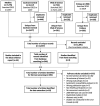Effectiveness of multimodal nutrition interventions during pregnancy to achieve 2009 Institute of Medicine gestational weight gain guidelines: a systematic review and meta-analysis
- PMID: 34263669
- PMCID: PMC8284157
- DOI: 10.1080/07853890.2021.1947521
Effectiveness of multimodal nutrition interventions during pregnancy to achieve 2009 Institute of Medicine gestational weight gain guidelines: a systematic review and meta-analysis
Abstract
Background: In 2009, the Institute of Medicine (IOM) published a revision to its 1990 recommendations on gestational weight gain (GWG). The objective of this review is to update a previous systematic review and meta-analysis to evaluate the effectiveness of nutrition interventions in achieving recommended GWG.
Methods: We conducted updated literature searches in MEDLINE® (2012 through 2019), Web of Science (2012 to 6 February 2017), Embase (2016 through 2019), and Cochrane Central Register of Controlled Trials (2012 through 2019). Literature published before January 2012 was identified from a published systematic review. We included controlled trials conducted in the U.S. or Canada among generally healthy pregnant women that compared nutrition interventions with or without exercise to controls (e.g., usual care) and reported total GWG or rate of GWG based on the 2009 IOM GWG guidelines. Two independent investigators conducted screening, data extraction, and risk-of-bias (ROB) assessment. Random-effects meta-analyses were conducted when data were sufficient.
Results: Eighteen unique studies were included, of which 11 were conducted in women with overweight or obesity. Nutrition interventions, compared to controls, had a similar effect on total GWG (mean difference = -1.24 kg; 95% CI [-2.65, 0.18]; I2=67.6%) but significantly decreased second and third trimester rate of GWG (-0.07 kg/week; 95% CI [-0.12, -0.03]; I2=54.7%). Nutrition interventions also reduced the risk of exceeding IOM's rate of GWG targets (pooled RR = 0.71; 95% CI [0.55, 0.92]; I2=86.3%). Meta-analyses showed no significant differences in achieving IOM's total GWG or any secondary outcome (e.g., preterm birth or small/large for gestational age) between groups. Most studies were assessed as having some or high ROB in at least two domains.
Conclusion: Multimodal nutrition interventions designed to meet the 2009 IOM's GWG targets may decrease the rate of GWG over the second and third trimesters but may not decrease total GWG.Key messagesExcessive gestational weight gain is associated with higher risk of many adverse maternal and fetal outcomes and represents a public health concern in the United States and Canada.Nutrition interventions designed to meet the 2009 IOM GWG guidelines may decrease the rates of GWG over the second and third trimesters but may not be effective at reducing total GWG.
Keywords: Nutrition intervention; gestational weight gain; meta-analysis; systematic review.
Conflict of interest statement
All authors declare no conflicts of interest.
Figures











Similar articles
-
Gestational weight gain during the second and third trimesters and adverse pregnancy outcomes, results from a prospective pregnancy cohort in urban Tanzania.Reprod Health. 2022 Jun 16;19(1):140. doi: 10.1186/s12978-022-01441-7. Reprod Health. 2022. PMID: 35710384 Free PMC article. Clinical Trial.
-
The effect of weight management interventions that include a diet component on weight-related outcomes in pregnant and postpartum women: a systematic review protocol.JBI Database System Rev Implement Rep. 2015 Jan;13(1):88-98. doi: 10.11124/jbisrir-2015-1812. JBI Database System Rev Implement Rep. 2015. PMID: 26447010
-
Counseling and Behavioral Interventions for Healthy Weight and Weight Gain in Pregnancy: A Systematic Review for the U.S. Preventive Services Task Force [Internet].Rockville (MD): Agency for Healthcare Research and Quality (US); 2021 May. Report No.: 20-05272-EF-1. Rockville (MD): Agency for Healthcare Research and Quality (US); 2021 May. Report No.: 20-05272-EF-1. PMID: 34110725 Free Books & Documents. Review.
-
Association of Antenatal Diet and Physical Activity-Based Interventions With Gestational Weight Gain and Pregnancy Outcomes: A Systematic Review and Meta-analysis.JAMA Intern Med. 2022 Feb 1;182(2):106-114. doi: 10.1001/jamainternmed.2021.6373. JAMA Intern Med. 2022. PMID: 34928300 Free PMC article.
-
Monitoring gestational weight gain and prepregnancy BMI using the 2009 IOM guidelines in the global population: a systematic review and meta-analysis.BMC Pregnancy Childbirth. 2020 Oct 27;20(1):649. doi: 10.1186/s12884-020-03335-7. BMC Pregnancy Childbirth. 2020. PMID: 33109112 Free PMC article.
Cited by
-
A Systematic Review and Bayesian Network Meta-Analysis Comparing In-Person, Remote, and Blended Interventions in Physical Activity, Diet, Education, and Behavioral Modification on Gestational Weight Gain among Overweight or Obese Pregnant Individuals.Adv Nutr. 2024 Jul;15(7):100253. doi: 10.1016/j.advnut.2024.100253. Epub 2024 Jun 13. Adv Nutr. 2024. PMID: 38879168 Free PMC article.
-
Effectiveness of a Brief Lifestyle Intervention in the Prenatal Care Setting to Prevent Excessive Gestational Weight Gain and Improve Maternal and Infant Health Outcomes.Int J Environ Res Public Health. 2022 May 11;19(10):5863. doi: 10.3390/ijerph19105863. Int J Environ Res Public Health. 2022. PMID: 35627403 Free PMC article.
-
Effects of Antenatal Lifestyle Interventions in Pregnant Women with Normal Body Mass Index.Iran J Public Health. 2023 Feb;52(2):381-388. doi: 10.18502/ijph.v52i2.11891. Iran J Public Health. 2023. PMID: 37089163 Free PMC article.
-
A mixed methods systematic review of midwives' clinical practices related to prenatal care of women with obesity.Midwifery. 2023 Jun;121:103653. doi: 10.1016/j.midw.2023.103653. Epub 2023 Mar 5. Midwifery. 2023. PMID: 36907010 Free PMC article.
-
Dietary and Nutrient Intake, Eating Habits, and Its Association with Maternal Gestational Weight Gain and Offspring's Birth Weight in Pregnant Adolescents.Nutrients. 2022 Oct 28;14(21):4545. doi: 10.3390/nu14214545. Nutrients. 2022. PMID: 36364806 Free PMC article.
References
-
- Johnson J, Clifton RG, Roberts JM, et al. ; Eunice Kennedy Shriver National Institute of Child Health and Human Development (NICHD) Maternal-Fetal Medicine Units (MFMU) Network . Pregnancy outcomes with weight gain above or below the 2009 Institute of Medicine guidelines. Obstet Gynecol. 2013;121(5):969–975. - PMC - PubMed
-
- Gibson KS, Waters TP, Catalano PM.. Maternal weight gain in women who develop gestational diabetes mellitus. Obstetr Gynecol. 2012;119(3):560–565. - PubMed
Publication types
MeSH terms
LinkOut - more resources
Full Text Sources
Other Literature Sources
Medical
